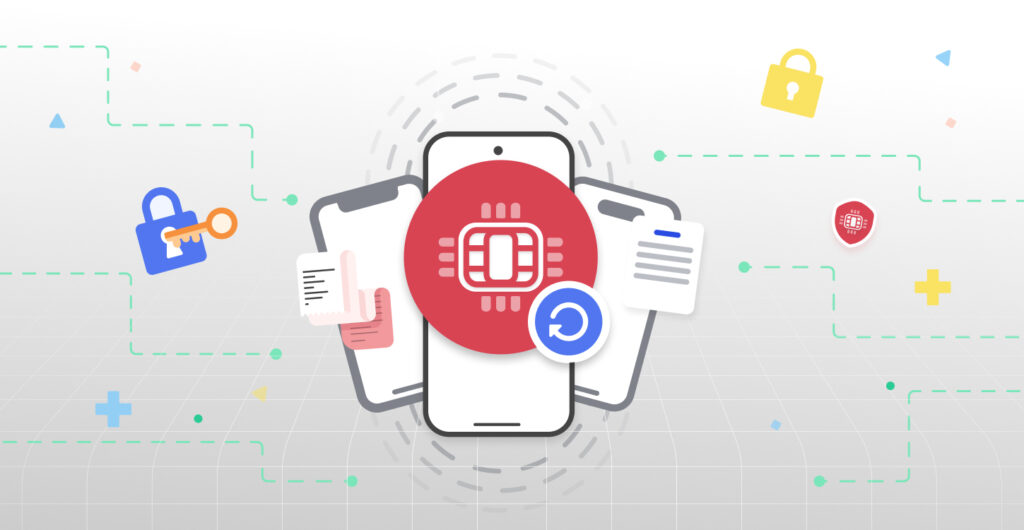
January 30, 2025
Safeguarding eSIMs: What Resellers Need to Know About Deletion and Reactivation
Some eSIM users delete their eSIMs by mistake while others do it intentionally. eSIM resellers must understand the needs of both parties and provide the needed help.
Many eSIM users enter panic mode when they mistakenly delete their eSIM profiles. We all struggle with new technology sometimes and eSIM technology is not an exception.
Similarly, some users delete their eSIM while troubleshooting security or connectivity issues.
Both categories of eSIM users want to know if they can recover their eSIM profiles and how to do it.
So, what does deleting an eSIM do and how can you as an eSIM reseller help these users recover them?
There is another category of eSIM user who wants to delete their eSIM profiles from a phone (because they want to sell the phone for example) and need a guarantee that someone else cannot activate them.
In that case, what can you as an eSIM reseller do to ensure that a third party does not reactivate those eSIM profiles?
In this article, we’ll attempt to answer all these questions. We’ll cover:
- What does deleting an eSIM do?
- How to help your customers recover a deleted eSIM
- How to prevent fraudulent reactivation of deleted eSIM
Do you want to seamlessly and securely resell eSIM connectivity services to your customers? Book a demo with zendit to see how you can easily integrate our plug-and-play API into your website and app.
1. What does deleting an eSIM do?
Unlike a physical SIM card, an eSIM card is embedded into a device and there is no way to remove it like you can do the former. So, when we talk about deleting an eSIM, we are referring to deleting an eSIM profile (also known as an eSIM account) from a device.
An eSIM profile contains all the data users need to access the services of a particular network operator or carrier. It includes the operator’s configurations, network settings, credentials, and other SIM-based applications.
eSIM users need to download and activate the eSIM profile associated with a particular network operator to access their connectivity services (eSIM data and voice plan). These downloaded data are stored on the phone’s internal memory.
When eSIM users delete an eSIM profile – whether intentionally or not – the stored data will be deleted from the internal memory. Since these data were responsible for network access, deletion means that eSIM users will lose access to mobile services.
In summary, what does deleting an eSIM do? It disables mobile connectivity from a carrier or network operator.
2. How to help your customers recover a deleted eSIM
As said above, there are three categories of eSIM users when it comes to deleting an eSIM. The first category of users does it unintentionally. Some mistakenly press the delete button while some do not remember to keep their eSIM profiles while conducting a factory reset.
A second category is those who delete eSIM profiles in an attempt to address security and connectivity issues. This is similar to uninstalling an app to address a certain malfunction.
The last category consists of users who intentionally delete their eSIM profiles because they don’t want to use the network again or they want to change their phones. Some are also travelers who activated the eSIM overseas but don’t plan to revisit the location where that eSIM was useful.
For the first two categories, the possibility of getting back an eSIM profile is a major concern. Some of them might reach out to you to help them find a solution so they don’t lose access to their connectivity services.
Those who do it unintentionally (first category) may have even contacted you about their inability to make phone calls, send text messages, or connect to the internet. It might be after this contact that they realize what has happened and in some instances, you may even be the one to first notice that the profile has been deleted.
So, does eSIM come back after you delete it?
Yes, eSIM users can reinstall an eSIM after deleting it. They can even retain the cellular plan (mobile plan) they had before the deletion.
What then can you do to help your customers who are trying to get their eSIM back? The following are the solutions you can explore in the order of simplicity:
- Reverting deletion: If the deletion is recent, there might be an option to quickly revert it before they lose the connection. This is similar to recovering a deleted Gmail account – within a certain window, users can recover deleted Gmail accounts.
You can inform your eSIM customers to check out this option on their device’s settings (specifically network & internet settings on Android and cellular settings on ios).
- Reinstalling the eSIM profile using the original QR code: If the user still has the original QR code they used to activate the eSIM, they can rescan it to recover the deleted eSIM. This is possible on both Apple and Android phones.
- Checking for backups: If the user is the type that regularly backs up their phone’s data, they could recover the eSIM profile data from their drive (Google Drive, One Drive, etc.)
- Contacting the carrier or network operator: If they can’t find the original QR code, they can request a new one from the carrier. Since you already have a business relationship with these carriers, you can help fast-track this process by informing them of the situation.
Similarly, if the reason for the initial deletion is security and connectivity issues with the carrier, you can also register complaints to the network operator (on behalf of your clients) to ensure that the issues are speedily resolved.
To prevent further issues, you can also advise your users to report connectivity and network issues to you or directly to the carrier before trying to troubleshoot by deleting the eSIM.
Similarly, most phones with eSIM capability have the option to do a factory reset while still keeping the eSIM profile. Below is an example for an Android phone:
Source: Nomad
For iPhone users, it looks like this:
Source: Holafly
Finally, encourage your eSIM customers to be more careful with eSIM management to avoid accidental deletion of eSIM profiles. They may also choose to install an eSIM management app to make things easier for them.
3. How to prevent fraudulent reactivation of deleted eSIM
There are instances where some users delete an eSIM because they want to change to a new eSIM profile (from Verizon to T-Mobile, for example).
In this case, all you need to do is provide them with eSIM plans from the new mobile network operator they have chosen. For these users, to keep eSIM or delete eSIM is all about the quality of service they get from their network operators.
We also have travelers who decide to keep eSIM or delete eSIM based on the probability that they will revisit a particular country.
However, in some cases, some users delete an eSIM profile as part of the preparation to change their phone – selling it or giving it out to someone else.
This category of users wants added assurance about eSIM security and a guarantee that they won’t fall victim to scammers who may want to reactivate the old eSIM on their own devices.
What can you do for these users? Below are some options:
- Advise them to reactivate the profile on the new device before giving out or selling the older device: Since the same eSIM profile cannot be active on two different phones, reactivating it on the new phone reduces the likelihood of a SIM swapping fraud.
- Encourage them to do a complete factory reset: A complete factory reset – that includes erasing eSIMs – will also make it less likely that a scammer gains access to the user’s eSIM profile and phone number.
- Educate them about eSIM security measures: eSIM users complying with general eSIM security measures are less likely to be victims of eSIM scams.
Therefore, encourage your customers to use strong passwords, activate multiple authentications, avoid unsolicited messages and unsecured WiFi networks, and regularly update their device’s software.
- Beef up your security systems: As an eSIM reseller, you can contribute to the safety and confidence of your customers by also employing essential security measures.
These include dealing with only reputable carriers, deploying secure activation channels, monitoring suspicious activities, having a dedicated customer service line, and paying attention to relevant industry standards.
Working with an eSIM platform like zendit is one way to make your eSIM customers less susceptible to eSIM scams either generally or in the process of deleting an eSIM.
At zendit, we provide you access to over 600 reputable and trustworthy mobile operators and service providers in over 190 countries. We also have a responsive customer service team that will quickly respond to any problems you or your customers face.
In addition, we employ security protocols that make integration of our API into your website or app as secure as possible. You can:
- Regenerate API keys if the previous ones have been tampered with.
- Whitelist API addresses and connect your integration with trusted hosts
- Secure your product catalog by disabling products you don’t plan to sell
- Use ShieldWall to authenticate transactions
- Verify the authenticity of all the webhooks you use in the integration process
Are you ready to provide hassle-free and secure eSIM connectivity services to your customers? Book a demo to see how zendit works or contact us to learn more about how our product can help your business.
Takeaways
- Deleting an eSIM means removing the eSIM profile (network settings and credentials) from a device, which disconnects users from their mobile network operator’s services.
- Users can recover deleted eSIM profiles by reverting the deletion (if recent), rescanning the original QR code, restoring from phone backups, or requesting a new QR code from the network operator. Resellers can expedite this process by liaising with carriers on behalf of customers.
- To prevent unauthorized reactivation of deleted eSIMs, users should either reactivate the profile on a new device or perform a complete factory reset, ensuring the eSIM profile is erased.
- eSIM users should embrace security measures like strong passwords and multiple authentications while eSIM resellers should use secure activation channels, monitor suspicious activities, and apply industry security standards.

